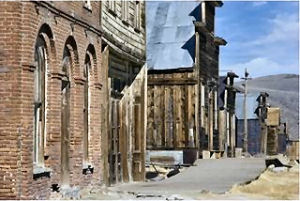California State Gold Rush Ghost Town
| Bodie |
|
Adopted:September 4, 2002 |
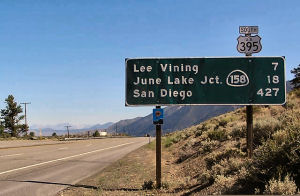 |
| South on U.S. Route 395: Mono Lake up ahead on left |
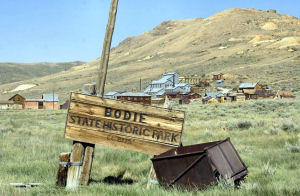 |
| Bodie, California Historic Park |
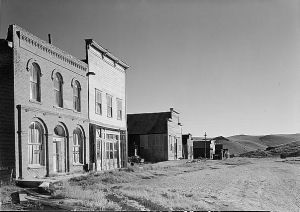 |
| Bodie Main Street 1918, Library of Congress |
Lee Vining, California is located at the base of the eastern escarpment of the Sierra Nevada on the shores of Mono Lake in Mono County, California. Lee Vining was established in 1852 as a mining camp.
Its 2000 census population was 488.
Bodie, about 25 miles northeast of Lee Vining, about 75 miles southeast of Lake Tahoe and about five miles from the Nevada state border, was also established as a mining camp (1859).
It's only inhabitants are three Park Rangers.
On July 4, 1961, the National Park Service established the Bodie Historic District and listed Bodie as a National Historic Landmark.
In 1962, the State of California took over the town of Bodie and, on September 12, 1964, Bodie was dedicated by the California State Park Commission as a State Historic Park.
Lee Vining High School serves approximately 50 students in grades seven through twelve. It was here that a conversation began that resulted in California Assembly Bill No. 1757 (AB 1757); a bill to designate Bodie as California's official state ghost town.
In 2002, State Assemblyman Robert "Tim" Leslie (Tahoe City) initiated an intended lesson in civics when he asked junior and senior high school students in his district to suggest legislation for introduction in the California General Assembly. A group of seventh and eighth grade students at Lee Vining High School took Mr. Leslie up on his "Write-a-Bill Challenge."
In response, the students came up with the idea of an official ghost town. Bodie, preserved in a state of "arrested decay" by the California State Park Commission, fit the bill.
"We kind of brainstormed and tried to find something that was relevant to our area," said Jeanine Barbato, the junior high teacher in Lee Vining.
Assembly Bill No. 1757, authored by Assemblyman Leslie, was introduced and read for the first time in the California General Assembly on January 7, 2002. The bill, as introduced, read
THE PEOPLE OF THE STATE OF CALIFORNIA DO ENACT AS FOLLOWS:
SECTION 1. The Legislature declares and finds all of the following:
(a) The town of Bodie was founded by Waterman S. Body in 1859, and rose to prominence due to mining in the nearby Comstock Lode.
(b) At its peak in 1879, Bodie boasted a population of 10,000 citizens and had a reputation for its wicked climate as well as its clientele.
(c) By 1882, the big strikes were mostly gone and with them the need to stay in Bodie.
(d) One hundred twenty years later, Bodie is one of the largest and best-preserved ghost towns in the West.
SEC. 2. It is the intent of the Legislature to enact legislation to commemorate the 120th anniversary of the decline of the town of Bodie from boomtown to ghost town. It is the further intent of the Legislature to join with the students and teachers of Lee Vining Junior High School in Lee Vining, to promote awareness of, and to acknowledge the importance that Bodie played in California's rich Gold Rush history.
SEC. 3. Section 429.7 is added to the Government Code, to read:
429.7. Bodie is the official state ghost town.
Jeanine Barbato and her students traveled to Sacramento to testify in favor of the bill.
Assembly Bill No. 1757 and the Lee Vining students amassed a group of supporters, including Doug Brodie and Jim Watson, authors of Big Bad Bodie: High Sierra Ghost Town , the Mono Basin Historical Society, the Mono County Historical Society, and a good number of individuals who wrote letters of support. , the Mono Basin Historical Society, the Mono County Historical Society, and a good number of individuals who wrote letters of support.
In the spring, supporters of Calico Ghost Town Regional Park, a popular tourist destination in southern California's San Bernardino County voiced some objections to the bill. They expressed concern that if Bodie was designated as the official state ghost town, it might create a disadvantage when competing for state and federal grants.
Assemblywoman Gloria Romero (Los Angeles) agreed with the opposition voiced by the County of San Bernardino and opposed AB 1757. She grew up in Barstow, about thirteen miles southwest of Calico and had visited the attraction often as a little girl. She credited Calico with giving her a sense of California history.
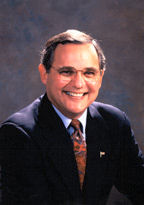 |
| California Assemblyman Tim Leslie |
Bill sponsor, Assemblyman Tim Leslie responded, "If you want a snow cone or shooting gallery experience, go to Calico, but if you want a true Scooby Doo experience, you have to go to Bodie."
Bodie and Calico were both established as mining camps and both towns flourished at roughly the same time. But, today they couldn't be more different.
Bodie is isolated. It can be found about 13 miles from U.S. Highway 395, northeast of Mammoth. It consists of 170 buildings suspended in "arrested decay." Miles from civilization and a paved road, rusty mining equipment remains on the street, looking like miners simply decided one day to abandon the place, according to Leslie.
"It's eerie," he said.
Calico Ghost Town Regional Park, 3 miles off Interstate 15 and only about 13 miles from Barstow, features rebuilt buildings, train rides, and restaurants. Every President's Day, they host Civil War re-enactments even though Calico was not a major battle site in the Civil War.
In spite of opposition, AB 1757 was passed (60 to 4) by a full vote of the Assembly on May 13, 2002 and advanced to the Senate.
Once in the Senate, things began to heat up however. The County of San Bernardino lodged opposition to the bill. Concern was again voiced that the official designation of Bodie would be a disadvantage to Calico when competing for state or federal grant money. They offered a history of Calico that rivaled that of Bodie.
Senator Jim Brulte (Rancho Cucamonga), representing the County of San Bernardino, stood in opposition to the bill. "I represent San Bernardino County. I've been to Calico, and I haven't been to the other place, so I'm going with what I know."
The conflict between Calico sympathizers and Bodie sympathizers stopped the bill dead, so to speak, in its tracks by the end of June.
But, like the historic mining towns of the 19th century, the legislation was not dead. As the legislative session began to wind down in August, Senator Debra Bowen (Marina del Ray) resurrected Assembly Bill No. 1757.
In their opposition to the bill, the County of San Bernardino had left an opening for compromise.
"The County points out that it would support AB 1757 if it were amended to make Bodie "a" official state ghost town rather than "the" official ghost town."
Senator Bowen took advantage of this opening and, in what she referred to as the "Great Ghost Town Compromise of 2002," suggested that AB 1757 should be amended to declare Bodie the "gold rush ghost town" of California. She further suggested that, in a subsequent session of the legislature, a bill should be introduced stipulating Calico as the "silver rush ghost town" of California.
The amendment spawned by the "Great Ghost Town Compromise of 2002" paved the way for the approval of the full Senate and the agreement of the full General Assembly.
On September 4, 2002 California Gray Davis signed the legislation adopting Bodie as the official state gold rush gold town of California.
In 2005, legislation was passed that made Calico the official state silver rush ghost town of California.
California Law
The following information was excerpted from the California Government Code, Title 1, Division 2, Chapter 2.
CALIFORNIA GOVERNMENT CODE
TITLE 1. GENERAL
DIVISION 2. STATE SEAL, FLAG, AND EMBLEMS
CHAPTER 2. STATE FLAG AND EMBLEMS
SECTION 420-429.8
429.7. Bodie is the official state gold rush ghost town.
Source: California State Legislature, California Law, (http://www.leginfo.ca.gov/calaw.html), February 10, 2008.
Source: State Names, Seals, Flags and Symbols: A Historical Guide Third Edition, Revised and Expanded by Benjamin F. Shearer and Barbara S. Shearer. Greenwood Press; 3 Sub edition (October 30, 2001).
Additional Information
Bodie State Historic Park:
Designated as a National Historic Site and a State Historic Park, the remains of Bodie are being preserved in a state of "arrested decay".
Bodie State Historic Park:
Descriptions and information about Bodie from Digital West Media, Inc.
Bodie, California:
From America West: Bodie Ghost Town.
Bodie, California:
Bodie entry in Wikipedia, the free encyclopedia.
Bodie, CA:
Great photographs from Ghost Town Gallery.
Big Bad Bodie: High Sierra Ghost Town :
Big Bad Bodie is an intriguing historical tale about life as it was lived in old Bodie, the hardships, the bad times, the good times, and the people that made Bodie what it was. Paperback: 191 pages, Publisher: Robert D. Reed Publishers (November 2002) :
Big Bad Bodie is an intriguing historical tale about life as it was lived in old Bodie, the hardships, the bad times, the good times, and the people that made Bodie what it was. Paperback: 191 pages, Publisher: Robert D. Reed Publishers (November 2002)
Bodie: "The Mines Are Looking Well..." :
The History of the Bodie Mining District, Mono County, California. Based on three decades of research, this book tells the story of mining in the former boomtown of Bodie, California. Paperback: 288 pages, Publisher: North Bay Books (March 2003) :
The History of the Bodie Mining District, Mono County, California. Based on three decades of research, this book tells the story of mining in the former boomtown of Bodie, California. Paperback: 288 pages, Publisher: North Bay Books (March 2003)
Bodie's Gold: Tall Tales And True History From A California Mining Town :
In Bodie's Gold, author Marguerite Sprague uncovers the original sources for information whenever possible, from the first mining claims to interviews with Bodieites alive today. Sprague has traced several popular Bodie legends back to their original sources, leading to revisions of beloved myths, more details about some others and a few interesting new stories. Paperback: 264 pages, Publisher: University of Nevada Press; New Ed edition (August 3, 2005) :
In Bodie's Gold, author Marguerite Sprague uncovers the original sources for information whenever possible, from the first mining claims to interviews with Bodieites alive today. Sprague has traced several popular Bodie legends back to their original sources, leading to revisions of beloved myths, more details about some others and a few interesting new stories. Paperback: 264 pages, Publisher: University of Nevada Press; New Ed edition (August 3, 2005)
|




